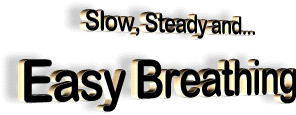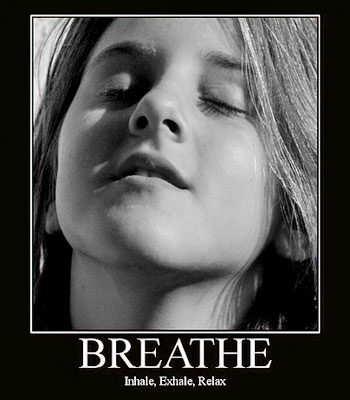|
by Mark Sircus from DrSircus Website
All doctors should know that chronically and even seriously ill people with dangerous acute infections will benefit immediately from controlling the quantity of air going into and out of a patient’s lungs.
With a simple breathing device - based on CO2 physiology - in the space of 20 minutes a day, one can begin, quite quickly, to get control of several important medical parameters, the most important of which is oxygen delivery to all cells and tissues.
When we practice breathing retraining it is almost like standing on a chariot with four wild horses and we pull back on the reins - limiting the air flow slowing everything down - we increase electron flow, raising cellular voltage, pH, and oxygenation as well as carbon dioxide levels. Just about everyone knows that the central key to curing cancer is found in raising pH and oxygen levels.
Most doctors though don’t want to know about the significance of something as basic as oxygen or as basic as therapeutic breathing exercises.
What’s the secret here? When we allow CO2 levels to rise back to normal levels we are allowing oxygen levels also to return to normal. It will take chapters to address carbon dioxide physiology and why CO2 is so essential for health.
Thinking of it simply as a poison or waste product is wrong medically speaking. Just for starters we can see that when CO2 levels go up to more normal levels the arteries and veins dilate allowing more blood and oxygen to reach the tissues. Blood pressure obviously would be lower under higher CO2 conditions.
When we deal with a person’s breath in a medical way we are able to quickly intervene on the most basic physiological parameters that affect the health of the cells. The second we pay attention to our breath our breathing changes and when we are emotionally upset we can see how quickly conscious breathing can bring us back to emotional tranquility.
That’s what we feel on an emotional level but on a cellular level the cells start to sing a more beautiful song as oxygen and CO2 levels rise together through slower breathing.
Less is More
Medical studies have proven that the more we breathe, the less oxygen is provided for the vital organs of the body.
Does that sound upside down to you? Well it’s true.
Ideal breathing corresponds to very slow, light, and easy abdominal breathing (also called diaphragmatic or belly breathing), something that needs to be relearned (or learned) if one has high hopes of beating cancer or overcoming other chronic disorders.
It really is difficult to recover from anything when we are breathing wrong! Diaphragmatic breathing allows one to take normal breaths while maximizing the amount of oxygen that goes into the bloodstream.
Most people believe in benefits of deep breathing.
“Deep breathing” exercises and techniques, to anyone who knows something about breathing, does not suggest in any way that one should actually over breathe. Deep breathing is just another way of saying belly breathing as opposed to shallow superficial chest breathing.
Deep breathing should be very slow so that one accumulates more CO2 in the blood.
Deep breathing means breathing less air not more. Some people actually think it is wrong to call therapeutic breathing “deep breathing. If you breathe less and accumulate CO2, the correct name is “reduced breathing,” writes Artour Rakhimov, PhD, one of the great proponents of CO2 medicine.
When we shift the breathing of a person who has cancer, we instantly begin to beat back the horde of cancer cells that do not like increases in pH, oxygen, cell voltage or CO2! And cancer cells are not the only thing we need to be afraid of.
Jon Barron writes about two new superbugs: C. diff and K. pneumoniae that are evolving rapidly.
Not only are they now resistant to most antibiotics, but they have also learned to spread outside of hospitals. Yes, they were created in hospitals and nursing homes, but like dangerous escaped convicts, they have broken out of those prisons and now threaten anyone with a compromised immune system or less-than-optimal intestinal bacteria.
And like escaped convicts, they should be considered armed and dangerous!
We can powerfully treat both infections and cancer with sodium bicarbonate, which, when combined with “reduced breathing,” pulls the rug out from under all of these defective cells with a rapid shift of pH brought on by correct breathing 24 hours a day. Correct breathing is actually easy to learn and can become automatic with enough practice.
We actually do more than this with the breath. When we breathe less - using a breathing device - we directly influence the involuntary (sympathetic nervous system) that regulates blood pressure, heart rate, circulation, digestion and many other bodily functions. Slow breathing is convenient, lacks the potential side effects of medications and is easy to perform.
It can be hard to believe that something so easy and accessible can have so many benefits.
Breath is life so we can expect to feel more alive, vibrant and healthy if we bring our awareness to our breath and retrain the way we breathe. When we breathe perfectly we can live more perfectly in health because our breath is the most important source of energy.
Hippocrates said,
I suppose he knew what ancient oriental philosophers knew - that in the air is “an ocean of energy” ready to be tapped directly into.
Respiratory training is a very effective way to restore the body’s health at any age. From the ancient times it has been known how much bang for the buck can be had from breathing exercises.
The Chinese and ancient Indian civilizations developed hundreds of techniques. Now modern science has gotten into the act with breathing devices that, when used only 20 minutes a day, increases one’s oxygen and cellular voltage levels.
The secret is to slow down breathing. Healthy people breathe little (the norm is 6 L/min); sick people breathe faster taking in more air (about 12-15 L/min); the severely sick breathe even faster until there is hardly any oxygen left in the body and death arrives.
When we are looking to recover from disease, especially cancer, we cannot afford to overlook the central question of breathing.
Most doctors have no idea that people can go a long way toward solving their health problems by retraining their breathing because they are trapped by the pharmaceutical paradigm that rejects the natural world. Few people understand the importance of “natural breathing.”
This is the kind of spontaneous, whole-body breathing that one can observe in infants and young children.
Mantak Chia wrote,
Breathing correctly is important for living longer and it helps us to maintain positive emotions as well as helping keep our performance at its best in everyday activity.
We all breathe, all day, every day, so we might as well do it right. Since a breath is the very first and last physical activity we undertake in life, we should give it the consideration and importance it deserves in our pursuit of health and relaxation. We can live a long time without food and a couple of days without drinking, but life without breath is measured in minutes.
Unfortunately, it seems that unless one participates in or teaches yoga, breathing does not get the attention it deserves.
As soon as we pay attention to our breathing, it immediately changes, and that is the whole point. Breathing retraining entails bringing our awareness to our breath and to treat with respect something that is so important to maintaining our lives.
Crystal Tatum says,
Dennis Lewis, the author of the Tao of Breathing wrote,
Our poor breathing habits have arisen not only out of our psychosomatic “ignorance,” our lack of organic awareness, but also out of our unconscious need for a buffering mechanism to keep us from sensing and feeling the reality of our own deep-rooted fears and contradictions.
There is absolutely no doubt that superficial breathing ensures a superficial experience of ourselves and our lives and our relationships with others.
The American Academy of Cardiology says,
Learning to avoid or control
stress can help you avoid
If we were able to breathe “naturally” for even a small percentage of the more than 15,000 breaths we take during each waking day, we would be taking a huge step not only toward preventing many of the physical and psychological problems that have become endemic to modern life, but also toward supporting our own inner growth - the growth of awareness of who and what we really are, of our own essential being.
There is a profound effect to people’s health when they start dropping off a few of those thousands of breath.
If 15,000 is about normal what would life be like if we reduced that to 10,000 breaths a day or less?
Even Readers Digest gets into writing about breathing saying,
This is the machine to use for your breathing retaining and it really is quite nice to blow bubbles as one increase the oxygenation of ones cells and tissues.
Originally from Russia created to help asthma sufferers the Breathslim breathing device is serious medicine.
Sold in the United States it is now being marketed for weight loss because it increased oxygen and metabolism to a significant enough level as to burn more fat thus helping to lose weight and keep it off.
Conclusion
Bottom line is that we can literally create miracles in medicine simply by adjusting the flow of a person’s breath.
Doctors can be superheroes without all the pharmaceuticals by giving their patients a simple breathing device that gives them a non-toxic, inexpensive, non-invasive, natural way to:
...and simply improve the overall efficiency of the organs and body.
That’s in addition to increasing cell voltage and improving pH.
from
SattvicFamily Website
When you exhale, know that you’re
expelling the mental pressures, aggravations, and limitations that
may have held you back.
Therapists define anxiety as “physical
responses to given stimuli”; the foremost anxiety response is
shallow breathing. The ability to breathe slowly and fully counters
systematic tenseness and automatically replaces it with relaxation.
Think of breathing as a three-part process:
This way you’ll be sure to fill your
lungs instead of settling for the all-too-common superficial
breathing that doesn’t fully oxygenate the system.
Take it easy. Don’t hyperventilate.
Combining the two multiplies the
benefits of both.
And this, says just about everyone who
has looked into the matter, can change the pattern of your life.
|



